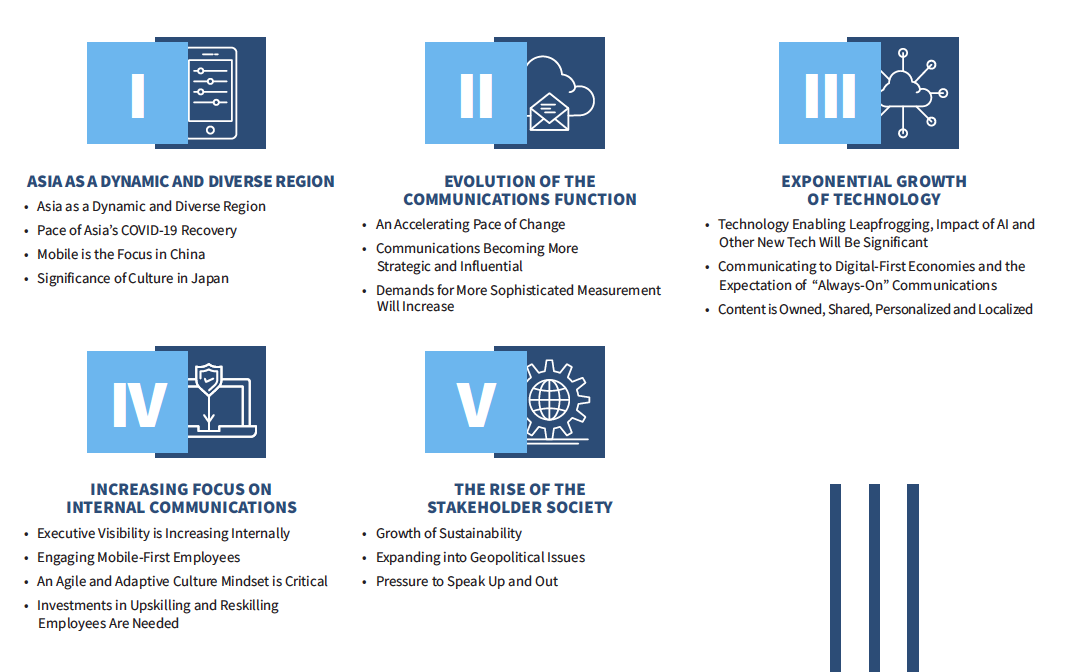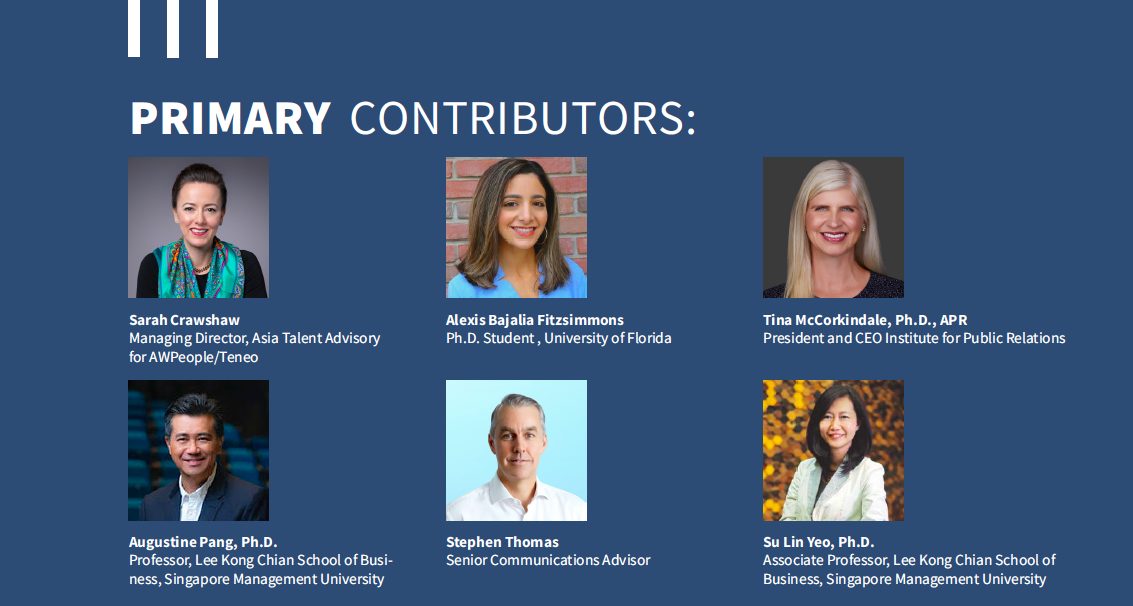Download Full Report: 2021 IPR Future of Communications in Asia Report
Download Presentation of Key Findings: Future of Comms in Asia Presentation (PDF)
Download Social Graphics: FOC Asia – Social Graphics

Introduction
The communication function within Asian-headquartered organizations is undergoing significant growth and changes that will be pivotal for its future success, according to a new Institute for Public Relations (IPR) research report. The “IPR Future of Communications in Asia” research report investigates key changes that will impact the future of the communications function. The analysis is based on interviews with 30 senior communications executives based in Asia in a variety of industries from 2019 to 2020, and three focus groups with nearly 20 senior communication leaders in late 2020.
Dr. Su Lin Yeo of Singapore Management University discusses the importance of research like this in Asia.

Five Key Themes:
Based on a thematic analysis of the interview and report transcripts, five major themes were uncovered that will impact the future of the function. Each theme within the report is a deep dive into the topics and subtopics. Verbatims from the research participants accompany each theme in the report. The five themes include:

I. Asia as a Dynamic and Diverse Region: Asia is a highly diverse region with changing stakeholder needs. This section outlines the pace of Asia’s COVID-19 recovery and how technology and culture, among other influences, will affect the communications function, especially in China and Japan.

II. Evolution of the Communications Function: With the accelerating pace of change, this section discusses how communications is becoming more strategic and influential. Also, it outlines how analytics and artificial intelligence will drive measurement in the communication field.

III. Exponential Growth of Technology: Technology in Asia leapfrogs compared to the West. This section describes the stakeholder demand for personalized and localized content as well as looks at the future of the PESO (paid-earned-shared-owned) model of communication. Additionally, the increased shift and demand to “always-on” communications is explored.

IV. Increasing Focus on Internal Communications: Executive visibility is increasing internally, but some executives are still uncomfortable with becoming more visible. This section discusses how the lines between personal and professional social media is blurring with employees increasingly expecting more mobile-first communication. More communicators are expecting to re-skill and up-skill employees to satisfy the changing needs of the function and the overall organization.

V. The Rise of The Stakeholder Society: External factors will significantly impact the communication function of the future. This section dives into how communication supports sustainability commitments, the increased focus on social issues, and expected and unexpected geopolitical changes that require flexibility within the function.

The report concludes with a column, “Strategic Communication in Asia,” by Dr. Su Lin Yeo, associate professor of communication management at Lee Kong China School of Business at Singapore Management University, who looks at the future practice of public relations in the East compared to the West, and the impact of all the factors outlined in the report.
Six communication leaders primarily contributed to the overall report including:

Special thanks to the IPR Task Force on Asia:
Deidre Campbell | Edelman
Joe Cohen | AXIS Capital
Rupen Desai | Dole Packaged Foods
Moyra Knight | Astellas & Astellas Foundation
Mike Schoenfeld | Duke University
Gerry Tschopp | Experian
Yanique Woodall | The Home Depot
Methodology
IPR conducted in-depth telephone and audio-conferencing interviews with 30 communications leaders at Asian-headquartered companies in 2019 and 2020. Because of changes to the communications function and business from COVID-19, IPR conducted three focus groups of nearly 20 Asia-based communications leaders in November and December 2020 to get additional insight into changes to the future of work.
Media Contact
Nikki Kesaris
Communications & Marketing Manager
Institute for Public Relations
nikki@instituteforpr.org
About the Institute for Public Relations
Founded in 1956, the Institute for Public Relations is an independent, nonprofit foundation dedicated to the science beneath the art of public relations.™ IPR creates, curates, and promotes research and initiatives that empower professionals with actionable insights and intelligence they can put to immediate use. IPR predicts and analyzes global factors transforming the profession, and amplifies and engages the profession globally through thought leadership and programming. All research is available free at www.instituteforpr.org and provides the basis for IPR’s professional conferences and events.
All materials copyrighted by the Institute for Public Relations.



